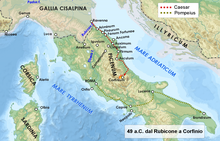Siege of Corfinium
This bloodless victory was a significant propaganda coup for Caesar and hastened the retreat of the main Optimate force from Italia, leaving the Populares in effective control of the entire peninsula.
In December 50 BC he wrote to the Senate asking if he could run for Consul in absentia without having to physically return to Rome where he could be apprehended; he also agreed to disband his legions if Pompey did the same.
Pompey and the Senate had a much larger pool of resources and men to draw upon but only 2 legions were present in the home province at the beginning of 49 BC, both stationed in southern Italy.
Both these legions had been recently transferred from Caesar's command, to take part in a planned war against Parthia, and had spent years fighting for him so their loyalty was far from certain.
The Spanish legions could be recalled, new recruits were being levied in Italy, and in the eastern provinces Pompey possessed a vast network of clients and allies from which he could call upon for wealth and men.
[10] Caesar immediately began a swift advance down the Italian Peninsula and made his first base at Ariminum, it was either at this point or previously at Ravenna that he addressed his men.
He spoke of the terrible injustices wrought upon him by his enemies, of his sadness at how his old friend and ally Pompey had turned against him through jealousy, and of how the Senate had trampled on the rights of the tribunes' veto.
[15] Lucius Domitius Ahenobarbus, Caesar's long time rival and the newly appointed replacement proconsul of his province of Transalpine Gaul, ignored Pompey's orders and instead fortified his men within the city of Corfinium which lay on the road to southern Italy.
These were all raw recruits and as a result Pompey sent numerous letters urging against the defence of the city, knowing they were at a severe disadvantage against Caesar's veterans who had spent the last decade fighting with him in Gaul.
[19] Meanwhile, Caesar learned the nearby Optimate-controlled city of Sulmo which lay seven miles beyond Corfinium was sympathetic to his cause and he sent Marcus Antonius with five cohorts of Legio XIII to see to its capture.
It was during this time that Caesar received reinforcements of his own in the form of Legio VIII, 22 newly recruited cohorts from Gaul and 300 auxiliary cavalry units from the king of Noricum all of which were stationed in a separate camp under the command of Curio, positioned on the opposite side of the city.
[22] Having uncovered the true nature of Pompey's response, this escape attempt was subsequently discovered by disgruntled senior officers within the city and they came together in agreement that despatches should be sent to Caesar that they would open the gates and deliver Ahenobarbus to him alive.
In total 50 of these such men were presented including Domitius Ahenobarbus and his son, Lentulus Spinther, as well as prominent senators such as Lucius Vibullius Rufus and Sextus Quintilius Varus.
[28] The treasury of Corfinium, some 6,000,000 sesterces,[29] was also delivered to Caesar though this he returned to Ahenobarbus as he knew it to be public funds raised by Pompey to pay the garrison and did not wish to appear to be more restrained with the lives of men than he was with their wealth.
[30] Caesar's stay at Corfinium lasted seven days in total and after accepting its surrender he immediately broke camp and set out into Apulia to pursue Pompey.
Upon learning of Caesar's victory Pompey began to march his army from Luceria to Canusium and then on to Brundisium where he could further retreat by crossing the Adriatic Sea to Epirus.
It was a significant propaganda victory, Caesar had shown clemency towards those he defeated from the outset of the war but never to a group so distinguished as this or made up of men so bitter in their hatred towards him.
By appearing to forgive his enemies and restraining his troops from taking any plunder he had ensured that the peoples of Italia, who were largely apathetic to the politics of the civil war, would remain welcoming to him.

